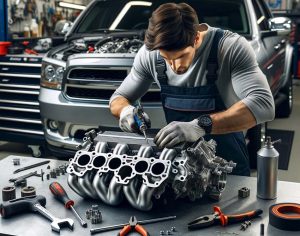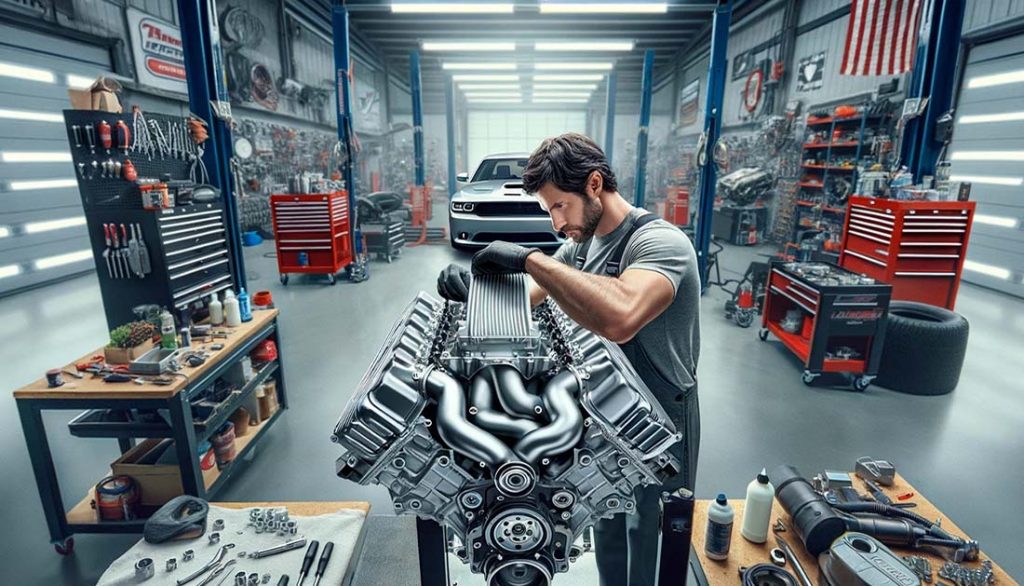Upgrading a 5.7 HEMI engine with a 6.1 intake manifold represents a significant enhancement strategy pursued by automotive enthusiasts keen on unlocking their vehicle’s full performance potential. This specific modification is celebrated for its direct impact on enhancing engine efficiency and power output. Central to this upgrade is the 6.1 intake manifold, an engineered component designed to optimize the delivery of air and fuel to the combustion chambers, thereby maximizing power generation. By diving deep into the technical specifics of this modification, including the nuances of compatibility and the tangible performance benefits, vehicle owners are equipped with comprehensive insights, enabling informed decision-making for this substantial engine enhancement.
Understanding the 6.1 Intake Manifold’s Role in Performance Enhancement
The 6.1 intake manifold is a pivotal component in the pursuit of heightened engine performance. Its design is meticulously crafted to enhance the flow of air and fuel directly into the engine, a critical factor in power output. Unlike standard intake manifolds, the 6.1 version is engineered to minimize airflow restrictions, thereby allowing a greater volume of air to mix with fuel. This enhanced air-to-fuel ratio significantly impacts combustion efficiency, directly influencing the engine’s power capabilities. The manifold’s material selection is also crucial, chosen for durability and the ability to withstand high operational temperatures, ensuring the upgrade not only boosts performance but also contributes to the engine’s durability and longevity.
Compatibility and Installation on the 5.7 HEMI Engine
Integrating a 6.1 intake manifold onto a 5.7 HEMI engine requires a deep dive into the specifics of engine design and compatibility. Despite their shared heritage in the HEMI family, discernible design differences between the 5.7 and 6.1 engines necessitate a detailed approach to ensure a successful modification. This involves a thorough assessment to ensure physical and operational compatibility, including potential modifications to the engine bay or manifold itself for a seamless fit. The upgrade process extends beyond mere physical installation, encompassing adjustments to the engine management system to optimize performance with the increased airflow. Such recalibrations are essential for harnessing the full potential of the enhanced air-fuel mixture, ensuring the engine performs efficiently with its new intake setup.
Performance Enhancements and Benefits
 Upgrading to a 6.1 intake manifold on a 5.7 HEMI engine ushers in a host of performance improvements that are directly noticeable in the vehicle’s operation. The enhancements span several key areas of engine performance:
Upgrading to a 6.1 intake manifold on a 5.7 HEMI engine ushers in a host of performance improvements that are directly noticeable in the vehicle’s operation. The enhancements span several key areas of engine performance:
-
Increased Horsepower and Torque: The primary benefit comes in the form of significantly increased horsepower and torque, thanks to the manifold’s superior airflow. This results in enhanced vehicle acceleration and improved power delivery across various driving conditions.
-
Improved Throttle Response: Drivers will experience a more responsive and engaging drive, with the engine reacting more swiftly to throttle inputs. This responsiveness enhances the overall driving experience, making the vehicle more enjoyable to operate.
-
Potential for Better Fuel Efficiency: While the focus of this upgrade is on performance, the more efficient air-fuel mixture can lead to improved combustion efficiency. In certain driving conditions, this may contribute to better fuel economy, offering an added benefit to the performance gains.
Installation Considerations and Potential Challenges
The installation of a 6.1 intake manifold on a 5.7 HEMI engine is a complex process that demands attention to detail and a comprehensive understanding of both the mechanical and electronic facets of the engine. Key considerations include ensuring compatibility with existing engine components, recalibrating the engine control unit (ECU) to accommodate the increased airflow, and making necessary adjustments to sensors and wiring. Potential challenges such as fitment issues and the need for custom modifications to the manifold or engine bay highlight the importance of expertise and precision in the upgrade process. Addressing these challenges effectively is crucial for achieving the desired performance improvements without compromising the engine’s reliability.
Conclusion
Opting for a 6.1 intake manifold upgrade on a 5.7 HEMI engine is a clear commitment to maximizing vehicle performance. This comprehensive modification not only elevates power output but also enhances the driving experience through improved efficiency and responsiveness. However, the intricate nature of the installation and potential for challenges underscore the necessity for meticulous planning and technical knowledge. With the correct approach and attention to detail, this modification can transform the vehicle’s performance, making it a rewarding endeavor for automotive enthusiasts dedicated to optimizing their driving experience.

